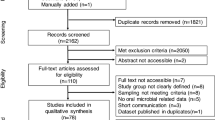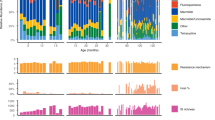Abstract
Data sources
PubMed, the Cochrane Library databases and the Virtual Health Library were searched from January 1950, with a manual search of the reference lists of the included studies.
Study selection
Duplicate papers, case reports, case series, descriptive studies, review articles, opinion articles and letters were excluded along with studies on children with oral defects, and ongoing preventative/restorative treatment and mothers who used antimicrobial substances. Two authors independently screened the title and abstract of all identified records, with consensus if required by a third author. A PECO (E= exposure) strategy was used to assess the eligibility of identified papers: observational human studies whose subjects were mother and child pairs; P contaminated by S.mutans; E comparison according to the presence and absence of S.mutans; C and whether there is vertical transmission (as defined by molecular analyses); O.
Data extraction and synthesis
Included studies were assessed for risk of bias. Two researchers extracted data on the methods, participants and outcomes, and the authors were contacted when it was necessary to clarify details. The percentage of transmission before and after the year 2000 was evaluated using the t-test and the molecular analysis technique was evaluated using ANOVA. A cumulative meta-analysis based on the publication year was performed, combining studies that assessed mother/child bionomy (pairs) and presented the percentage of transmission.
Results
Thirty-six cross-sectional studies were included, with the age of the children varying among the studies from three weeks to 15 years. All but one of the studies confirmed the vertical transmission of S. mutans from mother to child by genetic methods. The pooled cumulative meta-analysis demonstrated vertical transmission of S. mutans from mother to child (p<0.01) and showed a tendency of reduction in the percentage of vertical transmission compared with the year the studies were published.
There was no significant difference in the transmission rate according to the type of technique used (p=0.39; ANOVA test). Quality assessment found that twenty-eight studies had bias such as confounding factors. All of the studies included were cross-sectional studies and therefore none was randomised. There were no reports of blinding in the selected studies although some studies evaluated the testing accuracy and repeatability or calibration; all included microbiological repetition.
Conclusions
There is scientific evidence of vertical transmission of S. mutans from mother to child as there was an association between S. mutans strains in mothers and their respective children.
Similar content being viewed by others
Commentary
Caries development is a dynamic process and requires four factors to be present simultaneously: a susceptible tooth surface, bacteria (biofilm), fermentable carbohydrates (ie sugars) and time. Prevention of caries must therefore target at least one of these factors, for example, the regular removal of microbial biofilm by toothbrushing and restriction of sugar in the diet. Although there are a number of different cariogenic bacteria, S. mutans is thought to be one of the primary pathogens;1 prevention of transmission of this microorganism from a main carer to a child may therefore aid in the reduction of dental caries. This systematic review sought to determine whether there is scientific evidence of S. mutans transmission from mother to child using methods of genetic identification that could demonstrate a relationship between maternal strains and child strains.
The review of this suspected transmission is useful, but the use of unusual language and misspelling of words made it, at times a little difficult to understand. There were also a number of contradictions in the text, as described below.
The PRISMA checklist for reporting of systematic reviews and meta-analyses was used to critically appraise this review. According to these guidelines, the abstract could have included a background to the review, data sources used, study appraisal and synthesis methods, the results, limitations and the systematic review registration number. With regards to the latter, it is unsure whether the review was registered.
The authors conducted a thorough search of the literature, although unfortunately did not consider publication bias; additional studies may have been identified if unpublished literature was sought. The eligibility criteria for study selection using a PECO strategy was appropriate. However, in accordance with PRISMA guidelines, a PICOS strategy would have included the study type (in this case, S= cross-sectional observation studies) and perhaps could have been included in the introduction rather than just the methodology. Data extraction was suitable to meet the primary outcome of the systematic review and steps were taken to clarify any unclear details. Due to the nature of the research, all included studies were cross-sectional observation studies and therefore, there is no randomisation to the exposure.
Assessment of the quality and risk of bias of the included studies was carried out using comprehensive guidelines described by Fowkes and Fulton2 and Fidalgo et al.,3 which, although thorough, fails to detail descriptively how and why studies may be biased. The analysis of the reviewed studies is represented in tabular form and allows the reader to carefully follow the quality assessment of each paper. This level of detail is impressive, however, the tables were difficult to read as they were spread across three pages. The authors might have considered removing or simplifying much of the information to ease interpretation.
Twenty-eight of the 36 included studies were found to have bias, such as confounding factors. Additionally, none of the papers reported blinding in terms of the genetic tests used; only 'some' evaluated the testing accuracy and repeatability of observations, or checked calibration; but all genetic tests described in the papers included microbial repetition. In conclusion there was a distinct lack of availability of high quality evidence. Despite this, the authors dismiss these flaws stating that the shortcomings do not influence the results since vertical transmission of S. mutans from mother to child was confirmed by genetic tests. Without knowing the direction or magnitude of the bias and without any further discussion on the limitations of the studies selected it is difficult to understand how the authors came to this conclusion. Likewise, the use of the study data in the meta-analysis should be considered with caution keeping in mind the lack of high quality data.
From our respect it appears that on average, after 2000 the selected studies tend to show a higher rate of transmission of S. mutans, with average transmission of 64% compared to 56% before 2000. There is some confusion in the authors' interpretation of the results. They state that the differences in transmission rates between the studies are due to the different genetic tests used, but conversely that an ANOVA test demonstrated no statistical difference between the tests. The authors state that there is a reduction in transmission rates after the year 2000, which is due to an improvement in the genetic tests; yet their calculations using t-tests showed that there was no significant difference in transmission rate over the years. These conflicting statements are confusing and raise the question of the reliability of the studies used, their analysis and the conclusions drawn.
It is unclear why a cumulative meta-analysis taking into account the year of publication has been carried out and the significance of this analysis. The authors state that it shows a reduction in the percentage of vertical transmission and attribute this to the improvement in genetic testing methods over the years, which conflicts with the t-test result as discussed above.
All except one of the 36 included studies demonstrated mother-to-child transmission of S. mutans, and as a result of these findings, caries preventative measures could be applied to mothers so as to limit the transmission of S. mutans to children. As the authors mention in their discussion, a significant proportion of children also receive their strains of S. mutans from their fathers or from an unknown source and it is likely that children will eventually acquire this microorganism as the authors found that transmission occurred regardless of the child's age.
The authors of this systematic review do recognise that there is a wide variation in the age of children in the studies and it may have been possible to split up and analyse the data in relation to the child's age. This analysis would be useful from a public health perspective; if the age at which transmission of S. mutans most frequently occurs is identified, it may be possible to target preventative interventions and delay transmission and in turn reduce caries experience.
Practice point
-
Genetic tests demonstrate a relationship between the Mutans Streptococci within mothers, and their children, showing that most children derive at least one of their oral pathogenic bacteria from their primary carers.
References
Hausen H . Caries prediction--state of the art. Community Dent Oral Epidemiol 1997; 25: 87–96.
Fowkes FG, Fulton PM . Critical appraisal of published research: introductory guidelines. Br Med J 1991; 302: 1136–1140.
Fidalgo TK, Freitas-Fernandes LB, Ammari M, Mattos CT, de Souza IP, Maia LC . The relationship between unspecific s-IgA and dental caries: a systematic review and meta-analysis. J Dent 2014; 42: 1372–1381.
Author information
Authors and Affiliations
Additional information
Address for correspondence: Ivete Pomarico Ribeiro de Souza, Department of Pediatric Dentistry and Orthodontics, School of Dentistry, Universidade Federal do Rio de Janeiro, Rio de Janeiro, Brazil. E-mail: pomarico@gmail.com.
da Silva Bastos Vde A, Freitas-Fernandes LB, Fidalgo TK, Martins C, Mattos CT, de Souza IP, Maia LC. Mother-to-child transmission of Streptococcus mutans: a systematic review and meta-analysis. J Dent 2015; 43: 181–191.
Rights and permissions
About this article
Cite this article
Binks, C., Duane, B. Mother-to-child transmission of Streptococcus mutans. Evid Based Dent 16, 39–40 (2015). https://doi.org/10.1038/sj.ebd.6401089
Published:
Issue Date:
DOI: https://doi.org/10.1038/sj.ebd.6401089
This article is cited by
-
Transmission patterns of Streptococcus mutans demonstrated by a combined rep-PCR and MLST approach
Clinical Oral Investigations (2018)
-
The influence of mothers’ oral health behaviour and perception thereof on the dental health of their children
EPMA Journal (2018)



